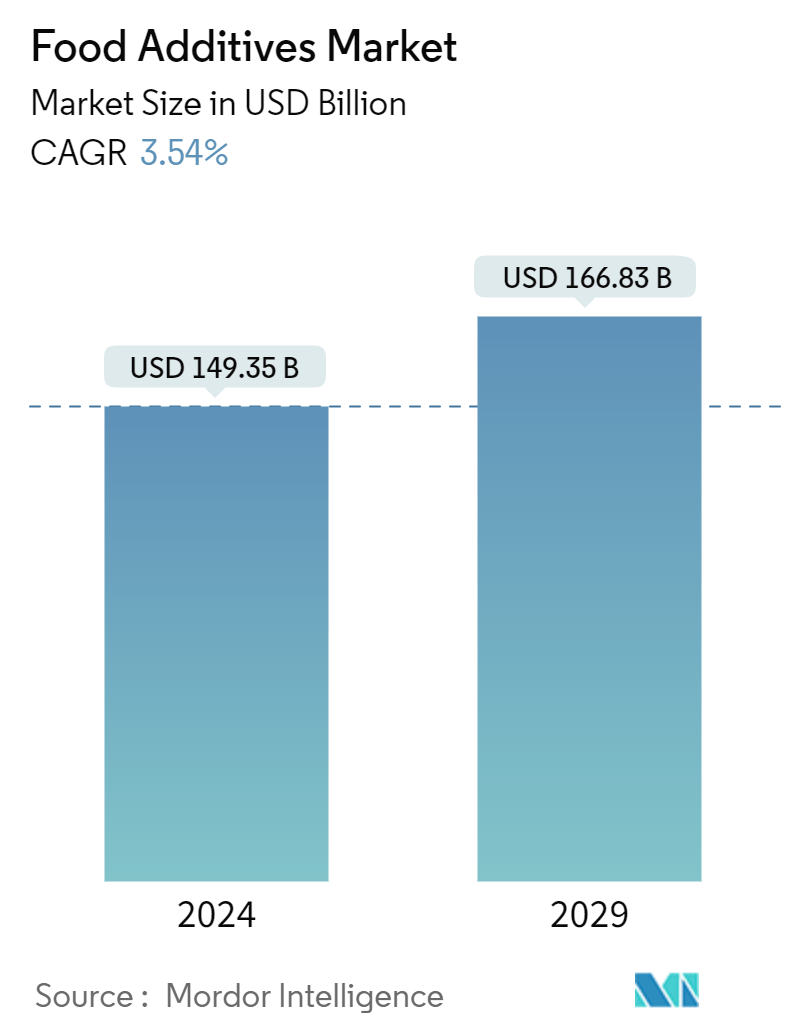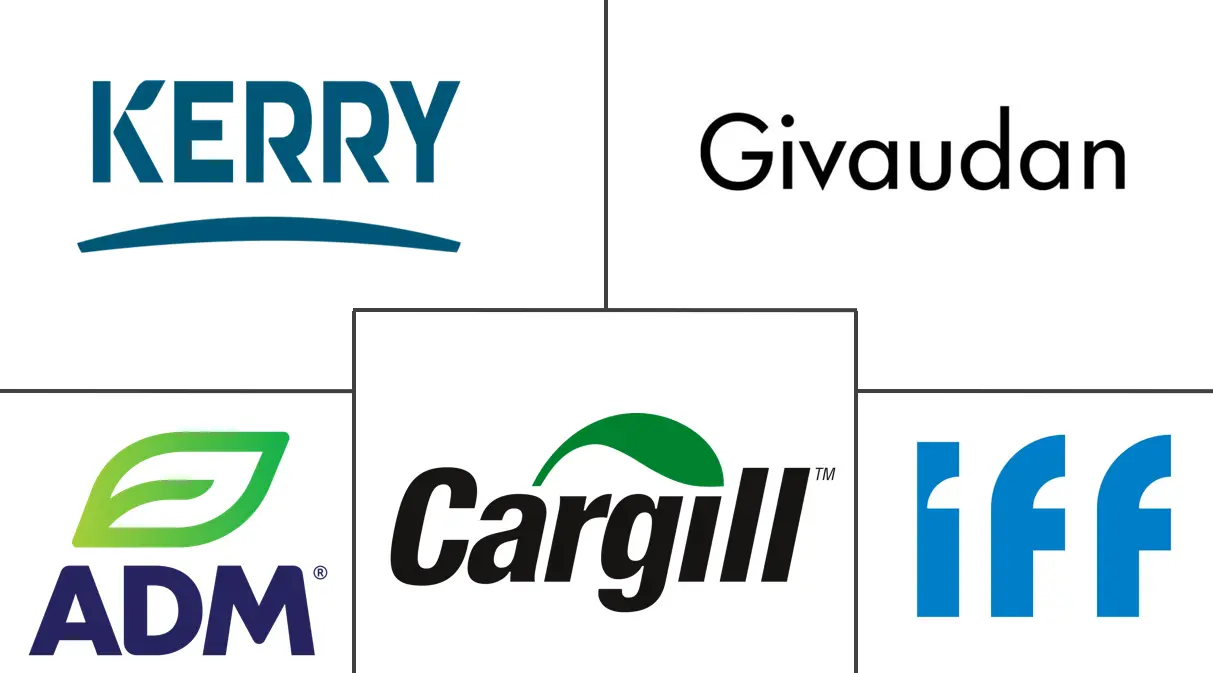Market Size of Food Additives Industry

| Study Period | 2019 - 2029 |
| Market Size (2024) | USD 149.35 Billion |
| Market Size (2029) | USD 166.83 Billion |
| CAGR (2024 - 2029) | 3.54 % |
| Fastest Growing Market | Asia Pacific |
| Largest Market | North America |
| Market Concentration | Low |
Major Players
*Disclaimer: Major Players sorted in no particular order |
Food Additives Market Analysis
The Food Additives Market size is estimated at USD 149.35 billion in 2024, and is expected to reach USD 166.83 billion by 2029, growing at a CAGR of 3.54% during the forecast period (2024-2029).
Driven by their multifunctionality, food additives like sweeteners, organic acids, and hydrocolloids are witnessing a surge in demand. These additives play diverse roles in food manufacturing, from structuring food and beverages to enhancing their nutritional profile and flavor, making them increasingly sought after by food companies. The market growth is further fueled by a rising appetite for convenience, ethnic, and processed food products, amplifying the need for advanced food packaging and processing solutions. Additives are extensively used to maintain the freshness, safety, taste, appearance, and texture of these processed and convenience food products. A testament to this trend, a 2023 survey by plant technology firm Ayana Bio, dubbed the “Ultra-processed Food Pulse survey,” revealed that 82% of U.S. adults incorporate ultra-processed foods into their diets. Technologies at the forefront of the Industrial Revolution 4.0, such as artificial intelligence (AI) - encompassing CNN, ANN, fuzzy logic, and machine learning - are revolutionizing the production of ingredient additives. These technologies ensure the additives are cost-effective and nutrient-rich and optimize key attributes like high bioactive content (e.g., antioxidants), sustainability, authenticity, stability, and purity. Responding to the rising demand for sustainable food products with ethical claims, major ingredient companies like Cargill Inc. and Archer Daniels Midland Company are leveraging AI tools in their supply chains. This integration fosters transparency, bolstering consumer trust and brand loyalty. The global trend towards plant-based food is amplifying the demand for natural and clean-label ingredients, particularly in categories like colorants, acidulants, and hydrocolloids. Labels boasting terms like GMO-free, natural preservatives, and organic are significantly propelling market growth. Given the worldwide uptick in processed food consumption and a preference for organic additives, the demand for food additives is poised to rise in the medium term.
Food Additives Industry Segmentation
Food additives are substances added to food products to maintain or improve their safety, freshness, taste, texture, or appearance.
The global food additives market is segmented by product type, application, and geography. Based on product type, the market is segmented into preservatives, bulk sweeteners, sugar substitutes, emulsifiers, anti-caking agents, enzymes, hydrocolloids, food flavors and enhancers, food colorants, and acidulants. Based on application, the market is segmented into bakery and confectionery, dairy and desserts, beverages, meat and meat products, soups, sauces, dressings, and other applications. Furthermore, the market is segmented by geography into North America, Europe, Asia-Pacific, South America, and the Middle East and Africa.
The market sizing has been done in value terms in USD for all the abovementioned segments.
| Product Type | ||||||||
| ||||||||
| ||||||||
| ||||||||
| ||||||||
| ||||||||
| ||||||||
| ||||||||
| ||||||||
| ||||||||
|
| By Application | |
| Bakery and Confectionery | |
| Dairy and Desserts | |
| Beverages | |
| Meat and Meat Products | |
| Soups, Sauces, and Dressings | |
| Other Applications |
| Geography | |||||||||
| |||||||||
| |||||||||
| |||||||||
| |||||||||
|
Food Additives Market Size Summary
The food additives market is experiencing significant growth, driven by the multifunctionality of additives such as sweeteners, organic acids, and hydrocolloids. These additives play a crucial role in various segments of the food manufacturing process, enhancing the nutritional profile, flavor, and texture of food and beverages. The increasing demand for convenience, ethnic, and processed foods is further propelling the market, as these foods require effective packaging and processing solutions to maintain freshness and safety. The rise in urbanization and a growing middle-income population globally are contributing to the increased consumption of processed and packaged foods, thereby boosting the demand for food additives. Technological advancements, including artificial intelligence and machine learning, are enabling the production of cost-effective and nutrient-rich ingredient additives, enhancing their appeal to food manufacturers.
The global food additives market is highly competitive, with major players like Cargill Incorporated, Archer Daniels Midland Company, and International Flavors and Fragrances Inc. leading the industry. These companies are focusing on strategic initiatives such as mergers, acquisitions, and partnerships to expand their market presence and develop new products. The demand for natural and clean-label food ingredients is on the rise, driven by the trend of plant-based food consumption and the growing preference for sustainable and ethically sourced products. China, as the largest producer and consumer of food additives, is significantly influencing the market dynamics, supported by its economic development and increasing middle-income population. The market is expected to continue its growth trajectory, fueled by the rising demand for ultra-processed foods and the ongoing innovations in food technology.
Food Additives Market Size - Table of Contents
-
1. MARKET DYNAMICS
-
1.1 Market Drivers
-
1.1.1 Consumer Demand For Processed Food
-
1.1.2 Rise Of Shelf-Stable Products
-
-
1.2 Market Restraints
-
1.2.1 Stringent Government Regulations
-
1.2.2 Health Impact Of Food Additives
-
-
1.3 Porter's Five Forces Analysis
-
1.3.1 Bargaining Power of Suppliers
-
1.3.2 Bargaining Power of Buyers
-
1.3.3 Threat of New Entrants
-
1.3.4 Threat of Substitute Products
-
1.3.5 Degree of Competition
-
-
-
2. MARKET SEGMENTATION
-
2.1 Product Type
-
2.1.1 Preservatives
-
2.1.1.1 Natural
-
2.1.1.2 Synthetic
-
2.1.1.2.1 Sorbates
-
2.1.1.2.2 Benzoates
-
2.1.1.2.3 Other Preservatives
-
-
-
2.1.2 Bulk Sweeteners
-
2.1.2.1 Sucrose
-
2.1.2.2 Fructose
-
2.1.2.3 High-fructose Corn Syrup
-
2.1.2.4 Lactose
-
2.1.2.5 Other Bulk Sweeteners
-
-
2.1.3 Sugar Substitutes
-
2.1.3.1 Sucralose
-
2.1.3.2 Xylitol
-
2.1.3.3 Stevia
-
2.1.3.4 Aspartame
-
2.1.3.5 Saccharin
-
2.1.3.6 Other Sugar Substitutes
-
-
2.1.4 Emulsifiers
-
2.1.4.1 Mono- and Di-Glycerides and Derivatives
-
2.1.4.2 Lecithin
-
2.1.4.3 Sorbate Esters
-
2.1.4.4 Other Emulsifiers
-
-
2.1.5 Anti-caking Agents
-
2.1.5.1 Calcium Compounds
-
2.1.5.2 Sodium Compounds
-
2.1.5.3 Silicon Dioxide
-
2.1.5.4 Other Anti-caking Agents
-
-
2.1.6 Enzymes
-
2.1.6.1 Carbohydrases
-
2.1.6.2 Proteases
-
2.1.6.3 Lipases
-
2.1.6.4 Other Enzymes
-
-
2.1.7 Hydrocolloids
-
2.1.7.1 Starch
-
2.1.7.2 Gelatin
-
2.1.7.3 Xanthan Gum
-
2.1.7.4 Other Hydrocolloids
-
-
2.1.8 Food Flavors and Enhancers
-
2.1.8.1 Natural Flavors
-
2.1.8.2 Synthetic Flavors
-
2.1.8.3 Flavor Enhancers
-
-
2.1.9 Food Colorants
-
2.1.9.1 Synthetic Food Colorants
-
2.1.9.2 Natural Food Colorants
-
-
2.1.10 Acidulants
-
2.1.10.1 Citric Acid
-
2.1.10.2 Phosphoric Acid
-
2.1.10.3 Lactic Acid
-
2.1.10.4 Other Acidulants
-
-
-
2.2 By Application
-
2.2.1 Bakery and Confectionery
-
2.2.2 Dairy and Desserts
-
2.2.3 Beverages
-
2.2.4 Meat and Meat Products
-
2.2.5 Soups, Sauces, and Dressings
-
2.2.6 Other Applications
-
-
2.3 Geography
-
2.3.1 North America
-
2.3.1.1 United States
-
2.3.1.2 Canada
-
2.3.1.3 Mexico
-
2.3.1.4 Rest of North America
-
-
2.3.2 Europe
-
2.3.2.1 Germany
-
2.3.2.2 United Kingdom
-
2.3.2.3 Spain
-
2.3.2.4 France
-
2.3.2.5 Italy
-
2.3.2.6 Russia
-
2.3.2.7 Rest of Europe
-
-
2.3.3 Asia-Pacific
-
2.3.3.1 China
-
2.3.3.2 Japan
-
2.3.3.3 India
-
2.3.3.4 Australia
-
2.3.3.5 Rest of Asia-Pacific
-
-
2.3.4 South America
-
2.3.4.1 Brazil
-
2.3.4.2 Argentina
-
2.3.4.3 Rest of South America
-
-
2.3.5 Middle East and Africa
-
2.3.5.1 Saudi Arabia
-
2.3.5.2 South Africa
-
2.3.5.3 Rest of Middle East and Africa
-
-
-
Food Additives Market Size FAQs
How big is the Food Additives Market?
The Food Additives Market size is expected to reach USD 154.64 billion in 2025 and grow at a CAGR of 3.54% to reach USD 184.02 billion by 2030.
What is the current Food Additives Market size?
In 2025, the Food Additives Market size is expected to reach USD 154.64 billion.

